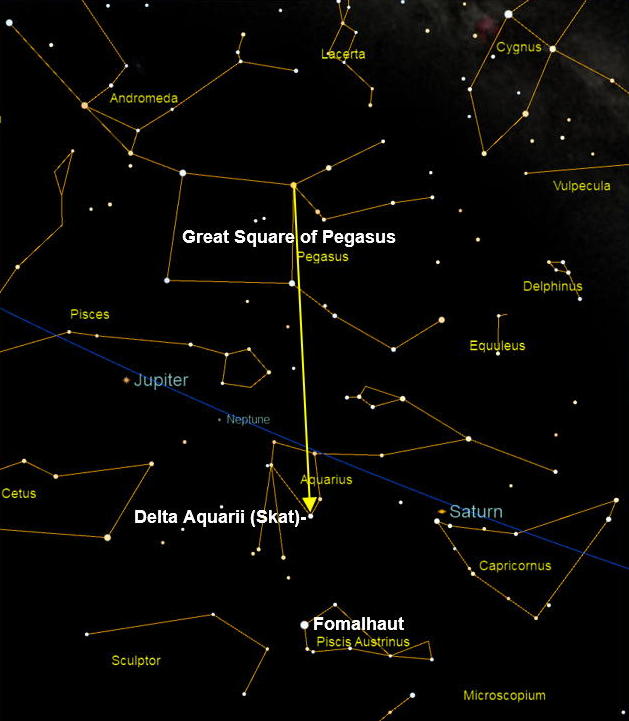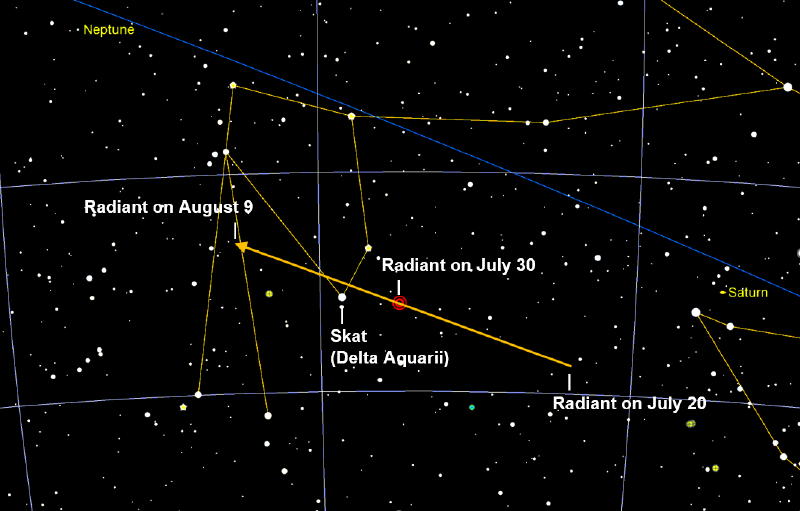
The Delta Aquariid meteor shower has a broad maximum and produces meteors throughout late July and early August. It overlaps with the more famous Perseid meteor shower, which peaks this year on the mornings of August 11, 12 and 13. The Delta Aquariid shower takes its name from the star Skat – also known by its Greek designation Delta Aquarii. If you trace the paths of the meteors backward, you’ll find that all Delta Aquariids appear to originate from a point near this star. This point – near Skat – is called the radiant point of the Delta Aquariid meteor shower.
Don’t confuse the Delta Aquariids with the Eta Aquariids. The Delta Aquariids take place in July, and the Eta Aquariids in early May. Each has a different parent comet and the two meteor showers are not related to each other. The star Eta Aquariid is even more obscure than its neighbor Delta. Aquarius has a lot of obscure stars.
Finding Delta Aquarii
Skat isn’t a bright star. It ranks as only the third brightest in the dim constellation Aquarius the Water Bearer. Still, you can glimpse this constellation and this star, if you go someplace nice and dark. If you’re in the Northern Hemisphere, you’ll also need a good view to the south. From mid-latitudes in the Southern Hemisphere, the star and constellation are northward and higher in the sky.
Skat or Delta Aquarii appears modestly bright in a dark country sky. It’s north of a very bright star, Fomalhaut in the constellation Piscis Austrinus the Southern Fish.
If you can see the Great Square of Pegasus and Fomalhaut, they can help you find Skat.
In late July and early August, when the Delta Aquariid meteors are flying, Skat and its constellation Aquarius rise above the horizon in the hours between midnight and dawn. Aquarius and Skat are best seen in the evening sky in the months of October, November, and December.
No matter when you look, you’ll always find Skat to the south (or below) the Great Square of Pegasus and to the north (or above) the bright star Fomalhaut. See the map below.

Of course, in actuality, the Delta Aquariid meteors have nothing whatever to do with the star Skat. The meteors burn up some 60 miles (100 km) above Earth’s surface. Skat lies about 160 light-years away.
Why is there a picture of railroad tracks in an article about meteor radiants?
A meteor shower results when the Earth passes through the orbital path of a comet, and the debris from this passing comet vaporizes in the Earth’s upper atmosphere. The meteors enter Earth’s atmosphere on parallel paths.
Seeing them come from a radiant point in the sky is much the same illusion as standing on railroad tracks and seeing the tracks converge in the distance.

Of course, in actuality, the Delta Aquariid meteors have nothing whatever to do with the railroad tracks. The meteors burn up some 60 miles (100 km) above Earth’s surface. The railroad tracks are right here on Earth. Caution: do not hang out at the railroad tracks thinking they will bring you more meteors. They won’t.
Who Moved My Railroad Tracks?
Now that we have found the star Skat, also known as Delta Aquarii, we can find the radiant of the Delta Aquariid meteor shower. Prepare to be shocked. OK, ready?
The radiant moves.
That wasn’t so bad, was it? You might be asking: Why hasn’t anyone told me that before? Well, it is not a well-known fact, and it does not make a big difference anyway since when you watch a meteor shower you should not be looking directly at the radiant. Astronomers are always warning newbies to not look at the sun. Maybe we should also add: And don’t look at that meteor radiant! Because that is not where you will find the meteors. Look off to the side, like 45 degrees off.
Getting back to this radiant drift, It’s surprising because we often see charts showing the location of radiant points with respect to this or that constellation. But those charts are set for the night of the shower’s peak. A map showing the radiant shift of the Delta Aquariids meteor shower is below.

Note one more thing. The meteor paths are generally longer the farther you look from the radiant. This is seen in the image below. The shorter paths are near the radiant. If you ever see a short flash during a meteor shower, it may be a meteor headed in your direction. But don’t worry, the comet fluff does not make it to the ground.

Bottom line: How to find the star Skat, or Delta Aquarii, the third-brightest star in the constellation Aquarius the Water Bearer, the radiant point for the Delta Aquariid meteor shower. Plus an explanation of why meteors in annual showers have radiant points, and how they drift.
Great Square of Pegasus: Easy to see
Read about all the major meteor showers: EarthSky’s meteor shower guide











